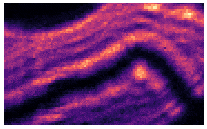Historically, spintronic devices were based on ferromagnets (FM) because the FM spins can be easily manipulated by an applied magnetic field. Recently, convenient methods for all-electrical antiferromagnetic (AFM) domain switching (e.g. using the Néel spin-orbit torque) were discovered, and devices containing AFM as key parts were demonstrated. AFM devices typically operate at THz frequencies, which is up to two orders of magnitude faster than typical FM, do not produce significant stray fields, and are largely immune to external magnetic noise, making them ideally suitable for device miniaturization. These advantages put AFM Spintronics to be the future of spintronics. Generally, understanding the development of magnetic domains with respect to the control parameter lies at the heart of any spintronics applications. Several attempts on visualizing domain formations were made using the photoemission electron microscopy, the contrast of which is provided by the x-ray magnetic linear dichroism (PEEM-XMLD). These attempts were partly successful; PEEM-XMLD measured images before and after applying currents or fields. Due to a long acquisition time of the technique (approx. 10 ~ 1000 sec), it does not measure the intermediate state and the dynamics of the AFM domains cannot be studied. To find out the detailed interplay between control parameters (electric currents, etc.) and AFM domains, domain dynamics in intermediate states should be investigated.
Our Research
Prof. Kim developed and demonstrated a new x-ray imaging technique with Prof. Kiryukhin at Rutgers University. This new technique provides a revolutionary way to visualize AFM domains and domain walls of many types, such as collinear or cycloidal AFM, within a fraction of a second and without any numerical reconstructions. We can study static and dynamic properties of AFM domains in quantum materials in real-time and in real-space.
 |
 |
Figure. (left) An image of AFM domain. Exposure time is 0.1 sec. (right) A real-time movie of dynamic domain movements.
We are interested in various AFM quantum magnets and thin films, such as unconventional magnetic superconductors, AFM topological insulators, CuMnAs, and Mn2Au thin films. In combination with various other x-ray imaging techniques (PEEM-XMLD, x-ray magnetic micro-diffraction, x-ray magnetic holography, etc.), we seek to develop a deeper understanding of exotic quantum magnets and their thin films. This research project will produce unprecedented, invaluable information about AFM domains and their future spintronics applications.
- Min Gyu Kim et al., “Real-Space Observation of Fluctuating Antiferromagnetic Domains,” Science Advances 8, eabj9493 (2022).
- Min Gyu Kim et al., “Imaging antiferromagnetic antiphase domain boundaries using magnetic Bragg diffraction phase contrast,” Nature Communications 9, 5013 (2018).